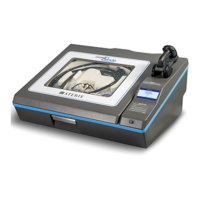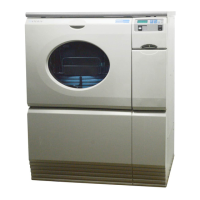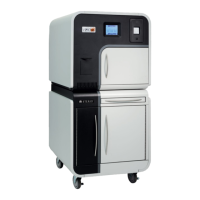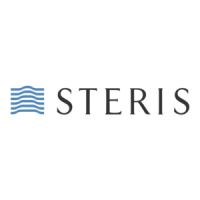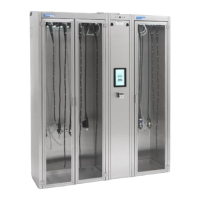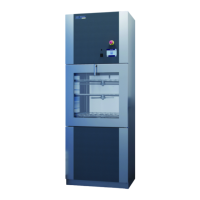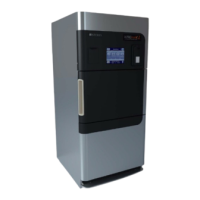3-4
764333-675
A water tight processing chamber is formed when the
inflatable seal forces the processing adapter tray
against the upper seal on the lid.
During the dump portion of the cycle, extensively
treated water flows from the inlet, through dump valve
(SOL5), past thermocouple #3 (drain block assembly;
TC3), and out the drain. The chamber and main system
plumbing are closed-off by the actuated drain pinch
valve (V5).
During chamber filling, water flows through inlet fill
valve (SOL7) and backflow preventer check valve
(CK4), across the membrane in the MaxPure Filter,
through the pressure transition block and into the
chamber. Circulation pinch valve (V6) is open, filling
circulation pump (P1), heater drain transition blocks
and the chamber. During fill, air exhausts through the
vent hole in the lid, into the float block, through CK2
and CK3, and out the drain. At completion of fill, water
enters the float block and raises the float. SOL7 is then
closed.
During circulation, fluid exits the chamber through the
right drogue of the processing adapter tray (under the
sterilant container), through the drain transition block,
past thermocouple #1 (drain transition block; TC1),
and into the heater housing. Fluid continues past the
heater and is flowed by circulation pump (P1) through
V6 to the high pressure transition block, past
concentration probes (CP1/ CP2) and thermocouple
#2 (high pressure transition block; TC2), and into the
processing chamber through the processing tray
container interface.
A portion of the fluid is flowed through the high
pressure pump (P2) at 16.5 +
3 psi for 60 Hz units,
through the smaller connector post/drogue to the
processing tray container adapter to provide higher
pressure directed flow for lumens. Also, a portion of
the fluid is circulated through the membrane and
housing of the MaxPure Filter.
The chamber is drained by P1 through V5 after V6 is
closed.
The float block assembly has two basic functions. First,
to maintain near-neutral chamber pressures. Second,
the float block assembly provides indication of
chamber-full condition and loss of fluid from the
chamber.
During fills, float block drain check valves (CK2 and
CK3) allow air to be purged from the chamber to drain,
and at the end of fills, allow any excess fluid to drain.
As fluid is pumped to drain, its volume in the chamber
is replaced by air drawn through sterile air filter (FLT2)
and air inlet check valve (CK1).
Chamber fills are terminated when air has been
exhausted and water enters the float block assembly,
which raises LS3. System fluid loss is detected when
the float switch drops. This drop occurs when a
sufficient fluid volume loss from the system and float
block assembly cracks open CK1, which lets air in,
displacing fluid from the float block and causing LS3
to drop.
3.3.2 Water Filter Housing Description
The housing of the MaxPure Filter assembly houses a
0.1-micron pharmaceutical sterilizing-grade filter to
provide filtered water to rinse processed instruments
and also provides an air-tight chamber around the
outside of the filter to accommodate pressure-hold
tests for filter integrity.
Following replacement of the MaxPure Filter
cartridge, through the removable housing cap, the
filter is surrounded by air, both inside and outside.
During a fill, water enters through CK4 and fills
around the outside of the filter. Air trapped outside
the filter is vented to drain through the normally
de-energized air-water solenoid valve (SOL8), and is
vented to drain through drain check valve (CK8).
Water passes through the MaxPure Filter and out the
housing's standpipe to the unit’s system plumbing.
During liquid chemical sterilant processing cycles,
sterilant circulates through CK11 and filter then into
the top port and out the standpipe port to liquid
chemically sterilize the inside and outside of the filter
and to remove any trapped air. Also, during
circulation, a positive pressure is generated by the
circulation pump (P1) and held in the filter housing by
the inlet and drain check valves (CK4 and CK8,
respectively).
At the end of every cycle and during DIAGNOSTICS,
the membrane test of the MaxPure Filter is conducted
to verify integrity of the membrane in the MaxPure
Filter. SOL8 is energized to close the path to drain and
to open the filter housing chamber, outside the
MaxPure Filter to the air manifold. Housing pressure
is allowed to stabilize, and then its decay is monitored
by the pressure transducer (PT1).
The MaxPure Water Filter Test has three phases.
• Pressurization
During pressurization phase, three way air water
solenoid valve (SOL8) is energized allowing the
filter housing to fill with compressed air. Two check
valves (CK4 and CK11) seat sealing air in the filter
housing. The compressor is enabled until the filter
housing pressure is greater than 55 psig monitored
by the pressure transducer PT1. The pressurization
of the housing is timed for three minutes and aborts
if the pressure is not reached in the allotted time.
• Stabilization
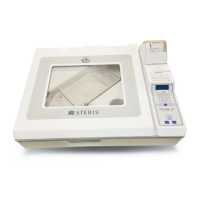
